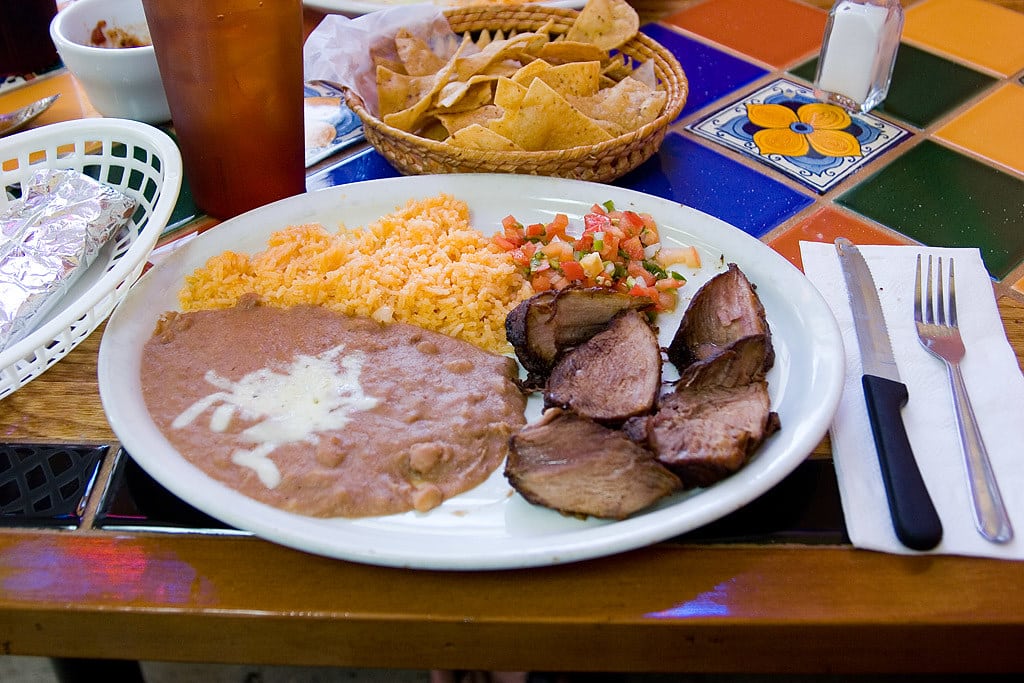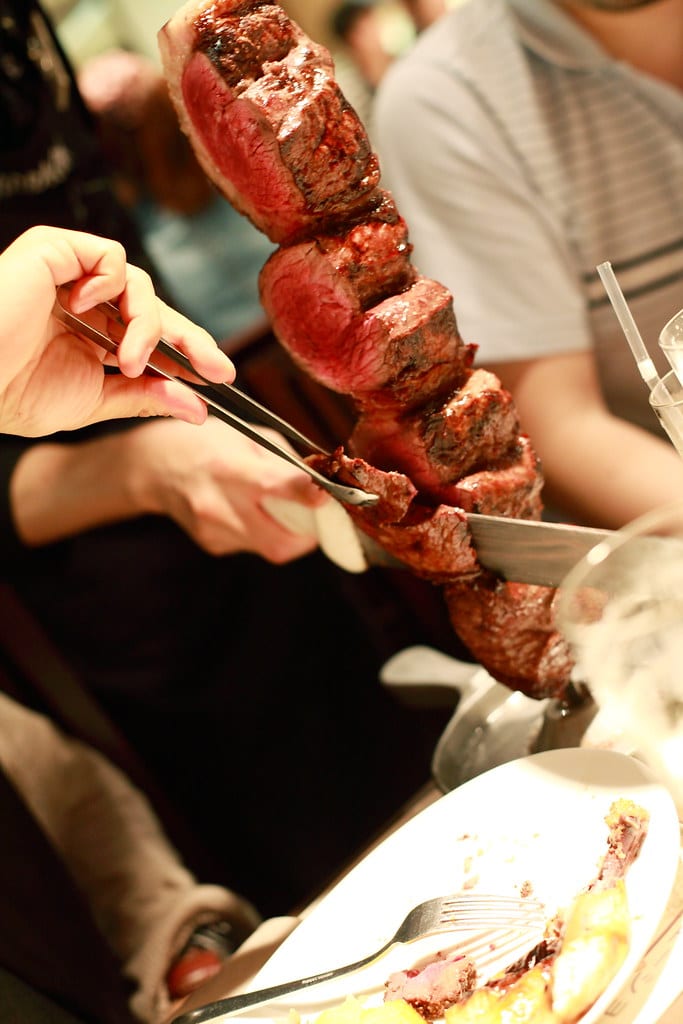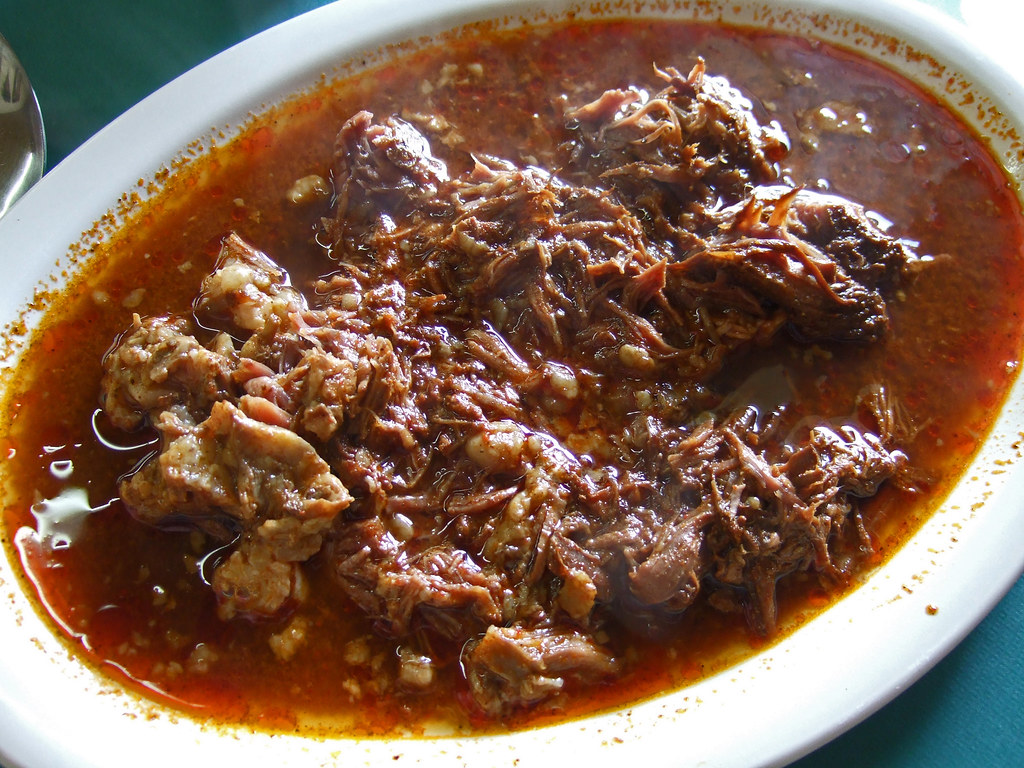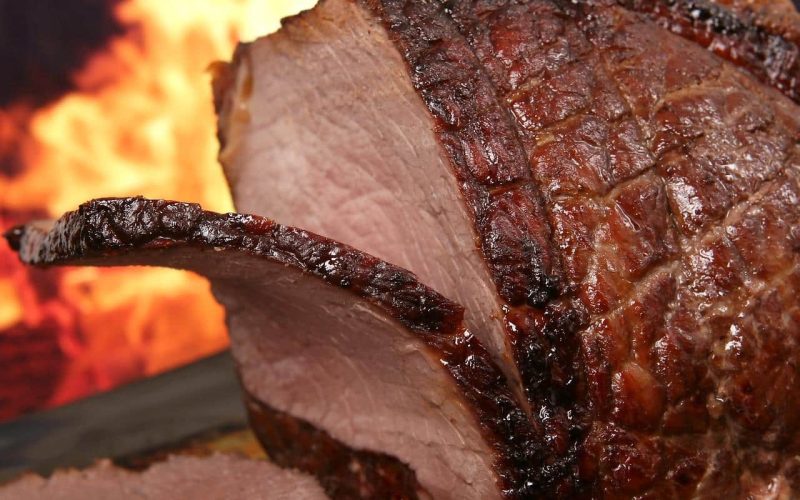Picture this: you’re walking through a bustling Mexican market, and the air is thick with the aroma of charred meat, smoky chilies, and sizzling fat.
Your stomach growls as vendors call out their specialties, each one promising flavors that’ll transport you straight to culinary heaven.
That’s the magic of Mexican meat dishes – they don’t just feed you, they tell stories of tradition, geography, and pure passion for cooking.
Mexican cuisine offers an incredible variety of meat preparations that’ll make your taste buds dance.
From the tender, slow-cooked carnitas that practically melt in your mouth to the bold, spicy kick of birria that warms you from the inside out, these different types of Mexican meat dishes represent centuries of culinary evolution.
You’re about to discover why each region of Mexico has developed its own signature ways of preparing meat, and how these techniques create flavors that are impossible to replicate anywhere else in the world.
Carnitas (Slow-cooked pork)

When you bite into authentic carnitas, you’re experiencing one of Mexico’s most beloved comfort foods. This traditional Mexican pork dish involves slow-cooking chunks of pork shoulder in their own fat until they become incredibly tender on the inside while developing those coveted crispy edges on the outside.
The beauty of carnitas lies in its simplicity and patience. You’ll typically find the meat cooked in large copper pots called “carnitas kettles” where it bubbles away for hours, developing complex flavors as the pork fat renders and concentrates. The result? Meat that’s so tender you can shred it with a fork, yet crispy enough to provide that satisfying textural contrast.
What makes carnitas special is the cooking method – it’s essentially pork confit, Mexican-style. The meat slowly braises in its own fat, which keeps it moist while allowing the surface to caramelize beautifully. You’ll often find carnitas served with warm tortillas, diced onions, cilantro, and a squeeze of lime, creating the perfect balance of rich, savory, and bright flavors.
Barbacoa (Pit-cooked meat, often beef or lamb)

Barbacoa represents one of Mexico’s most ancient cooking methods, dating back to pre-Hispanic times. When you try authentic barbacoa, you’re tasting history – this traditional technique involves wrapping seasoned meat in agave leaves and slow-cooking it in underground pits lined with hot coals.
The process is labor-intensive but worth every minute. The meat (traditionally lamb, goat, or beef cheeks) gets seasoned with a blend of chilies, garlic, and spices, then wrapped in agave leaves that impart a subtle, earthy flavor. After spending 8-12 hours in the pit, the meat emerges fork-tender and infused with smoky, complex flavors that modern cooking methods simply can’t replicate.
Modern barbacoa often uses beef cheeks or chuck roast, slow-cooked with dried chilies, garlic, and aromatic spices. The result is meat that falls apart at the touch of a fork, with a rich, deep flavor profile that’s perfect for tacos, especially weekend breakfast tacos paired with fresh salsa verde.
Birria (Spicy stewed meat, traditionally goat)

Birria might just be the most Instagram-worthy Mexican meat dish you’ll encounter, but don’t let its recent social media fame fool you – this spicy stewed meat dish has deep roots in Jalisco, Mexico. Originally made with goat meat, birria has evolved to include beef, lamb, or a combination of meats, creating a rich, aromatic stew that’s pure comfort food.
The magic happens in the consommé – a deeply flavorful broth made from dried chilies like guajillo, ancho, and chipotle, combined with tomatoes, onions, and a blend of spices including bay leaves, thyme, and marjoram. The meat slow-cooks in this fragrant liquid until it’s tender enough to shred easily.
What’s made birria explode in popularity recently is the quesabirria – where the shredded meat gets stuffed into tortillas with cheese, then griddled until crispy and served with the consommé for dipping. It’s messy, it’s indulgent, and it’s absolutely delicious. The combination of the rich, spicy broth with the crispy, cheesy exterior creates a textural and flavor experience that’s hard to beat.
Costillas de Puerco (Pork ribs)
Mexican pork ribs bring serious heat and flavor to the table, often marinated in a blend of dried chilies, garlic, and citrus before hitting the grill. These aren’t your typical sweet barbecue ribs – they’re bold, spicy, and deeply satisfying.
The preparation usually involves creating a marinade with rehydrated chilies like chipotle, guajillo, or ancho, combined with garlic, oregano, cumin, and orange juice. The acid from the citrus helps tenderize the meat while the chilies provide complex heat and smokiness. After marinating for several hours, the ribs get grilled over high heat, developing a beautiful char while staying juicy inside.
You’ll often find costillas de puerco served with grilled onions, nopales (cactus paddles), and plenty of lime wedges. The combination of the spicy, smoky meat with the fresh, acidic accompaniments creates a perfect balance that exemplifies Mexican flavor principles.
Chorizo (Spiced pork sausage)
Mexican chorizo is a completely different animal from its Spanish cousin – literally and figuratively. While Spanish chorizo is cured and ready to eat, Mexican chorizo is fresh, highly spiced, and needs to be cooked before eating. The flavor difference is dramatic and worth understanding.
Mexican chorizo typically combines ground pork with a vibrant blend of dried chilies, garlic, vinegar, and spices like cumin, oregano, and paprika. The mixture gets stuffed into natural casings or sold loose, ready to be crumbled and cooked. When you cook it, the fat renders out, creating a flavorful base that’s perfect for scrambled eggs, tacos, or adding to beans and rice.
The beauty of chorizo lies in its versatility. You can use it to flavor other dishes, stuff it into peppers, or simply enjoy it in warm tortillas with some diced onions and cilantro. Each region of Mexico has its own chorizo style – some spicier, some with different chili blends, but all delivering that distinctive Mexican sausage flavor.
Tripas (Beef intestines/tripe)
Tripas might challenge your comfort zone, but they’re an essential part of Mexican meat culture that shouldn’t be overlooked. These beef intestines, when properly prepared, become crispy on the outside while remaining tender inside, offering a unique texture that’s surprisingly addictive.
The key to great tripas is proper cleaning and preparation. The intestines get thoroughly cleaned, then often boiled or steamed until tender before being grilled or pan-fried until crispy. The result is a meat with a satisfying chew and a rich, beefy flavor that’s enhanced by the cooking process.
You’ll typically find tripas served simply – in warm tortillas with onions, cilantro, and salsa verde. The clean, bright flavors of the accompaniments complement the rich, savory taste of the meat perfectly. While tripas might not be for everyone, they represent an important aspect of Mexican cuisine’s nose-to-tail approach to cooking.
Lengua (Beef tongue)
Beef tongue might sound intimidating, but it’s actually one of the most tender, flavorful cuts you’ll find in Mexican cuisine. When properly prepared, lengua has a texture similar to the most tender roast beef, with a rich, beefy flavor that’s hard to match.
The preparation typically involves simmering the whole tongue in seasoned water with onions, garlic, bay leaves, and other aromatics until it’s fork-tender. Once cooked, the outer skin peels away easily, revealing the tender meat underneath. The tongue then gets sliced and often grilled or pan-fried to add some texture contrast.
Lengua tacos are incredibly popular because the meat is so tender and flavorful. The beef tongue pairs beautifully with simple accompaniments like diced onions, cilantro, and a squeeze of lime. Many people who try lengua for the first time are surprised by how much they enjoy it – the flavor is familiar and comforting rather than challenging.
Pollo Asado (Grilled chicken)
Pollo asado represents the perfect marriage of simplicity and flavor that defines great Mexican cooking. This grilled chicken dish relies on marinades and proper grilling technique to transform humble chicken into something extraordinary.
The typical marinade includes citrus juices (lime and orange), garlic, cumin, oregano, and often achiote paste, which gives the chicken its characteristic reddish color and earthy flavor. The acid in the citrus helps tenderize the meat while the spices create complex layers of flavor that penetrate deep into the chicken.
What sets Mexican grilled chicken apart is the technique – it’s often cooked over wood or charcoal, which adds a smoky element that gas grills simply can’t replicate. The chicken gets basted with the marinade during cooking, creating a beautiful, flavorful crust while keeping the meat juicy inside. You’ll often find it served with grilled onions, tortillas, and plenty of lime wedges.
Suadero (Thin cut of beef from between the leg and belly)
Suadero is one of those cuts that exemplifies Mexican cuisine’s ability to transform lesser-known parts of the animal into something spectacular. This thin cut of beef, taken from between the leg and belly, becomes incredibly tender when cooked properly and offers a unique texture that’s both meaty and slightly fatty.
The preparation usually involves slow-cooking the suadero on a flattop grill or comal, allowing the fat to render slowly while the meat develops a slightly crispy exterior. The result is meat that’s tender enough to cut with a fork but with enough texture to be satisfying in tacos.
Suadero has gained popularity in recent years as taco lovers discover its unique qualities. The meat has a rich, beefy flavor with just enough fat to keep it moist and flavorful. It’s often served simply, allowing the quality of the meat and the cooking technique to shine through.
Arrachera (Skirt steak)
Arrachera, or skirt steak, is the cut that made fajitas famous, but its Mexican preparations go far beyond the Tex-Mex interpretation. This flavorful cut, with its distinctive grain and rich taste, becomes incredibly tender when properly marinated and grilled.
The key to great arrachera lies in the marinade and cooking technique. Traditional marinades often include lime juice, garlic, cumin, and sometimes beer or tequila, which help tenderize the meat’s tough fibers. The steak needs to be cooked hot and fast – high heat sears the outside while keeping the inside juicy and tender.
What makes arrachera special is its intense beef flavor. The cut has more flavor than many premium steaks, and when sliced against the grain, it becomes remarkably tender. You’ll often find it served with grilled onions and peppers, warm tortillas, and fresh guacamole, creating a meal that’s both satisfying and full of bold flavors.
Carne Asada (Grilled beef)
Carne asada is perhaps the most iconic of all Mexican beef dishes, representing the perfect intersection of technique, flavor, and tradition. This grilled beef preparation varies significantly by region, but the goal remains the same – creating perfectly seasoned, tender beef with a beautiful char.
The meat selection varies, but flank steak, skirt steak, or sirloin are common choices. The key is in the marinade, which typically includes lime juice, garlic, cumin, and sometimes orange juice or beer. The acid helps tenderize the meat while the spices create complex flavor layers that complement the beef’s natural taste.
Proper carne asada requires high heat and careful timing. The meat should develop a beautiful char on the outside while remaining pink and juicy inside. It’s often served family-style with warm tortillas, fresh salsa, guacamole, and grilled onions, allowing everyone to build their own tacos exactly how they like them.
Tinga (Shredded chicken in chipotle sauce)
Tinga transforms simple chicken into something spectacular through the magic of chipotle chilies and tomatoes. This shredded chicken dish from Puebla combines tender, slow-cooked chicken with a smoky, spicy sauce that’s absolutely addictive.
The preparation involves cooking chicken until it’s tender enough to shred easily, then combining it with a sauce made from chipotle chilies in adobo, tomatoes, onions, and garlic. The chipotle chilies provide both heat and that distinctive smoky flavor that makes tinga so appealing.
What makes tinga special is its versatility and depth of flavor. The chicken absorbs the smoky, spicy sauce while maintaining its tender texture. You’ll find it used in tacos, tostadas, quesadillas, and countless other applications. The combination of tender chicken with the bold, smoky sauce creates a perfect balance that works in numerous dishes.
Al Pastor (Spit-grilled marinated pork)
Al pastor represents one of Mexico’s most successful fusion dishes, combining Middle Eastern cooking techniques with Mexican flavors. This spit-grilled marinated pork dish has become synonymous with Mexican street food and represents the country’s ability to adapt and perfect foreign influences.
The pork gets marinated in a blend of dried chilies, pineapple, onions, and achiote paste, creating a complex flavor profile that’s both spicy and slightly sweet. The meat then gets layered on a vertical spit, similar to shawarma, and cooked slowly while rotating, allowing the outside to develop a beautiful char while staying juicy inside.
The traditional serving method involves shaving thin slices of the cooked meat directly onto small tortillas, often topped with diced onions, cilantro, and a slice of grilled pineapple. The combination of the spicy, smoky pork with the sweet pineapple creates a flavor balance that’s uniquely Mexican and absolutely delicious.
Machaca (Dried shredded beef)
Machaca represents Mexican cuisine’s practical approach to meat preservation, transforming fresh beef into a shelf-stable ingredient that’s packed with flavor. This dried shredded beef originated in northern Mexico as a way to preserve meat in the desert climate, but it’s evolved into a beloved dish in its own right.
The traditional method involves salting and air-drying strips of beef until they’re completely dehydrated, then rehydrating them with liquid and seasonings. Modern machaca often starts with fresh beef that’s cooked and shredded, then dried or prepared to mimic the traditional texture and flavor.
When prepared for eating, machaca gets rehydrated and often combined with scrambled eggs, creating machaca con huevos – a popular breakfast dish. The meat has an intense, concentrated beef flavor that’s enhanced by the drying process, creating a dish that’s both satisfying and distinctive.
Cabrito (Kid goat)
Cabrito, or young goat, is especially popular in northern Mexico, where it’s often roasted whole over open fires. This tender, flavorful meat offers a unique taste that’s somewhere between lamb and beef, with a distinctive character that’s worth seeking out.
The preparation varies by region, but cabrito is often seasoned simply with salt, pepper, and perhaps some garlic, allowing the natural flavor of the meat to shine through. The cooking method – usually roasting over wood or charcoal – adds a smoky element that complements the meat’s natural taste.
Young goat has a milder flavor than mature goat, with tender meat that’s less gamey than lamb. When properly prepared, cabrito is incredibly tender and flavorful, representing a traditional protein source that’s still enjoyed throughout Mexico, especially in the northern states.
Chicharrón (Fried pork skin/belly)
Chicharrón takes pork skin and transforms it into something magical through the power of proper frying technique. These crispy, puffy pieces of fried pork skin offer an incredible textural experience that’s both satisfying and addictive.
The preparation involves cutting pork skin into pieces and slowly cooking them in their own fat until they puff up and become incredibly crispy. The result is something that’s crunchy on the outside but still has some chew, with an intense pork flavor that’s concentrated through the cooking process.
Chicharrón can be enjoyed on its own as a snack, added to tacos for textural contrast, or incorporated into other dishes for richness and crunch. The key is proper preparation – when done right, chicharrón should be light and crispy, not heavy or greasy.
Cecina (Salt-cured beef)
Cecina represents another traditional preservation method that’s created a distinct flavor profile all its own. This salt-cured beef undergoes a process that concentrates its flavor while creating a unique texture that’s both tender and slightly chewy.
The preparation involves coating thin slices of beef in salt and allowing them to cure, either air-dried or lightly smoked. The result is meat with an intense, concentrated flavor that’s both salty and deeply beefy. The texture is distinctive – not quite jerky, but definitely firmer than fresh beef.
Cecina is often grilled or pan-fried before serving, which adds another layer of flavor and texture. It’s frequently served with beans, tortillas, and fresh salsa, creating a meal that’s both simple and deeply satisfying.
Cabeza (Head meat, often beef)
Cabeza, or head meat, represents Mexican cuisine’s commitment to using every part of the animal. This tender, flavorful meat comes from the head of the cow and offers a unique taste and texture that’s prized by those who know good meat.
The preparation typically involves slow-cooking the entire head until the meat becomes incredibly tender and easily separates from the bone. The result is meat with varied textures – some parts are more tender, others have a bit more chew, but all are flavorful and satisfying.
Cabeza is often served in tacos, where its rich flavor is complemented by simple accompaniments like onions, cilantro, and salsa verde. The meat has a distinctive taste that’s both rich and clean, representing the kind of traditional preparation that’s at the heart of Mexican cuisine.
Mexican meat dishes represent far more than just food – they’re cultural expressions that tell the story of Mexico’s history, geography, and people.
From the ancient techniques of barbacoa to the fusion innovation of al pastor, each dish carries with it traditions that have been refined over generations.
Whether you’re drawn to the comfort of carnitas or the bold flavors of birria, these different types of Mexican meat dishes offer something for every palate and every occasion.
The next time you’re choosing what to eat, remember that each of these dishes represents centuries of culinary wisdom, waiting to transport you to the vibrant, flavorful world of Mexican cuisine.









I sure hope they didn’t pay you much for this article. It’s full of mistakes. You jump around too much and talk about recipes but give none. Have a bold title about pork but then talk about chicken. At one point you state (like in our restaurant) yet you have no restaurant and this article is not on a restaurants blog. Are you copy/pasting?? Man you should really read over your content before you post. And furthermore talk to whoever maintains this site and let them know it’s extremely annoying that it automatically capitalizes every word I’ve typed.
Best wishes to you